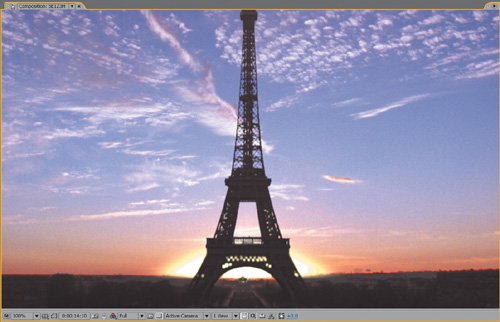Working with Light

There are two kinds of light: the glow that illuminates and the glare that obscures.
James Thurber
Light is the most complex phenomenon a compositor must understand, and in much the same way a painter or cinematographer understands it. In other areas of digital production, elaborate models are derived to simulate the way light works in the physical world. Accurate modeling of the physics of light is crucial to realistic 3D renders, and the science of light phenomena, such as radiosity, caustics, the inverse square law, environment mapping, and many more, have transitioned from theoretical papers delivered at SIGGRAPH to features readily available in high-end 3D software.
The world of the compositor is less pure and scientific, which if anything makes an understanding of light phenomena in a scene that much more significant. Like a painter, you must observe the workings of light in the three-dimensional world so that you can re-create them in a two-dimensional frame, using your software toolbox. Like a cinematographer, you must have a feeling for how lighting and color decisions affect the beauty and drama of a scene.
Notes
Chapter 11 introduced the radical idea that there are alternative color models to the ones with which you're already familiar and that one of these in particular, linear floating point, represents the direction in which digital imaging is headed. Linear floating point is supported natively in After Effects 7.0; the basic workflow was described in that previous chapter, and hands-on examples follow toward the end of this chapter.
Several chapters in this book have already touched upon principles of the behavior of light. Chapter 5, "Color Correction," focused on the most fundamental work of the compositor: matching the brightness and color of a foreground layer to a background source. Chapter 11, "Film, HDR, and 32 Bit Compositing," explored the complex issue of working with light values that extend beyond the range that your monitor can display.
This chapter is dedicated to situations in which you as a compositor must create or emulate specific lighting conditions in your scene. You'll explore the actual behavior of light, its direction, intensity, color, position, reflection, diffusion, occlusion, and volume, and methods of re-creating these in realistic and dramatic ways, including such special situations as backlighting, flares, glints, blurs, and defocused lenses. I'll distinguish between lighting conditions you can easily emulate and those that are essentially out of boundsalthough, for a compositor with a good eye and patience, the seemingly "impossible" can be met as a welcome challenge.
Light Source and Direction |
Section I. Working Foundations
The 7.0 Workflow
- The 7.0 Workflow
- Workspaces and Panels
- Making the Most of the UI
- Settings: Project, Footage, Composition
- Previews and OpenGL
- Effects & Presets
- Output: The Render Queue
- Study a Shot like an Effects Artist
The Timeline
- The Timeline
- Organization
- Animation Methods
- Keyframes and The Graph Editor
- Uber-mastery
- Transform Offsets
- Motion Blur
- Manipulating Time Itself
- In Conclusion
Selections: The Key to Compositing
- Selections: The Key to Compositing
- The Many Ways to Create Selections
- Compositing: Science and Nature
- Alpha Channels and Premultiplication
- Masks
- Combining Multiple Masks
- Putting Masks in Motion
- Blending Modes: The Real Deal
- Track Mattes
Optimizing Your Projects
- Optimizing Your Projects
- Navigating Multiple Compositions
- Precomposing and Nesting
- Adjustment and Guide Layers
- Understanding Rendering Order
- Optimizing After Effects
- Onward to Effects
Section II. Effects Compositing Essentials
Color Correction
Color Keying
- Color Keying
- Good Habits and Best Practices
- Linear Keyers and Hi-Con Mattes
- Blue-Screen and Green-Screen Keying
- Understanding and Optimizing Keylight
- Fixing Typical Problems
- Conclusion
Rotoscoping and Paint
- Rotoscoping and Paint
- Articulated Mattes
- Working Around Limitations
- Morphing
- Paint and Cloning
- Conclusion
Effective Motion Tracking
- Effective Motion Tracking
- The Essentials
- Optimizing Tracking Using 3D
- Extending a Track with Expressions
- Tracking for Rotoscoping
- Using 3D Tracking Data
- Conclusion
Virtual Cinematography
- Virtual Cinematography
- 5D: Pick Up the Camera
- Storytelling and the Camera
- Camera Blur
- The Role of Grain
- Film and Video Looks
- Conclusion
Expressions
- Expressions
- Logic and Grammar
- Muting Keyframes
- Linking Animation Data
- Looping Animations
- Smoothing and Destabilizing
- Offsetting Layers and Time
- Conditionals and Triggers
- Tell Me More
Film, HDR, and 32 Bit Compositing
- Film, HDR, and 32 Bit Compositing
- Details
- Film 101
- Dynamic Range
- Cineon Log Space
- Video Gamma Space
- Battle of the Color Spaces
- Floating Point
- 32 Bits per Channel
- Conclusion
Section III. Creative Explorations
Working with Light
- Working with Light
- Light Source and Direction
- Creating a Look with Color
- Backlighting, Flares, Light Volume
- Shadows and Reflected Light
- HDR Lighting
- Conclusion
Climate: Air, Water, Smoke, Clouds
- Climate: Air, Water, Smoke, Clouds
- Particulate Matter
- Sky Replacement
- The Fog, Smoke, or Mist Rolls In
- Billowing Smoke
- Wind
- Water
- Conclusion
Pyrotechnics: Fire, Explosions, Energy Phenomena
- Pyrotechnics: Fire, Explosions, Energy Phenomena
- Firearms
- Sci-Fi Weaponry
- Heat Distortion
- Fire
- Explosions
- In a Blaze of Glory
Learning to See
Index
EAN: 2147483647
Pages: 157
